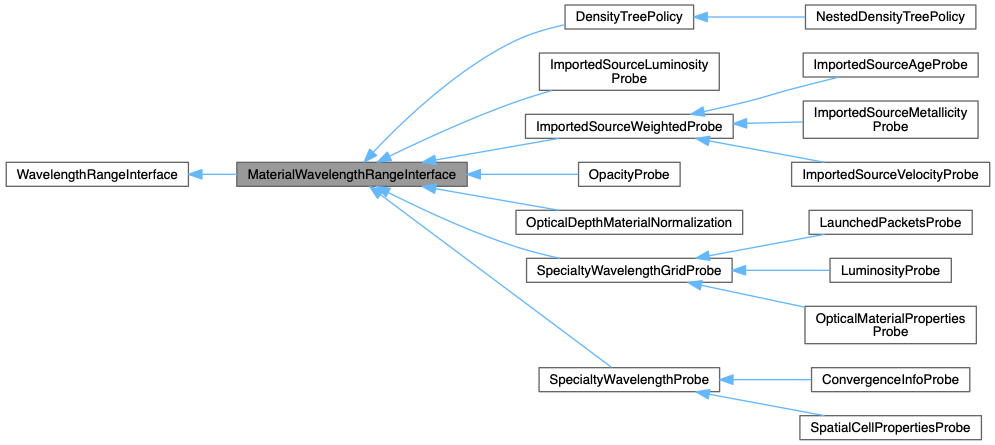#include <MaterialWavelengthRangeInterface.hpp>

Public Member Functions | |
| virtual WavelengthGrid * | materialWavelengthGrid () const |
 Public Member Functions inherited from WavelengthRangeInterface Public Member Functions inherited from WavelengthRangeInterface | |
| virtual | ~WavelengthRangeInterface () |
| virtual Range | wavelengthRange () const =0 |
Protected Member Functions | |
| MaterialWavelengthRangeInterface () | |
 Protected Member Functions inherited from WavelengthRangeInterface Protected Member Functions inherited from WavelengthRangeInterface | |
| WavelengthRangeInterface () | |
MaterialWavelengthRangeInterface is an interface implemented by simulation items other than sources, media and instruments to indicate that the simulation item may require wavelength-dependent material properties for a given range or set of wavelengths. This allows the Configuration object to determine the wavelengths for which material properties must be provided in a particular simulation without requiring a compile-time dependence on the types of the requesting objects.
This interface extends the WavelengthRangeInterface interface, which declares the wavelengthRange() function, allowing to selectively search for this interface as opposed to other interfaces inheriting WavelengthRangeInterface.
Because the Configuration object uses this interface very early in the setup process, the wavelengthRange() function implementation should not rely on the receiving object being already set up. In other words, the wavelengthRange() function may need to call setup() on itself or on the children on which its implementation depends.
In case the wavelengthRange() function determines at run-time (e.g. depending on user-configurable options) that no wavelength-dependent material properties will be requested by the object, the function can return a default-constructed range (i.e. [0,0]) to indicate this.
This interface additionally defines the materialWavelengthGrid() function, which should be implemented by subclasses that require material properties for the characteristic wavelengths of a wavelength grid. Because a default implementation is provided here for this function, this class is technically a mix-in class rather than a pure interface.
|
inlineprotected |
The empty constructor for the interface.
|
inlinevirtual |
If the receiving simulation item requires material properties at the characteristic wavelengths of a wavelength grid, this function returns a pointer to that wavelength grid. Otherwise the function returns the null pointer. The default implementation provided here returns the null pointer.
Reimplemented in ImportedSourceLuminosityProbe, and SpecialtyWavelengthGridProbe.